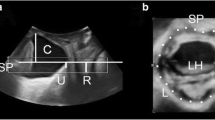Abstract
Introduction and hypothesis
Female pelvic organ prolapse is highly prevalent and childbirth has been shown to be an important risk factor. The study was carried out to observe if pelvic organ support deteriorates over time following a first birth.
Methods
This is a retrospective review using archived data sets of women seen in the context of two prospective perinatal imaging studies. All subjects had undergone a standardised interview, a clinical examination and 4D translabial ultrasound, 3 months and 2–5 years post-partum. Main outcome measures were pelvic organ descent and hiatal area at maximum Valsalva manoeuvre. Means at the two time points were compared using paired Student’s t test. Predictors of change over time in continuous variables were explored using linear modelling methods.
Results
A total of 300 women had at least two postnatal follow-ups. They were first seen on average 0.39 (SD 0.2, range 0.2–2.1) years and again 3.1 (SD 1.5, range 1.4–8) years after the index delivery, with a mean interval of 2.71 (SD 1.5, range 0.7–7.7) years, providing a total of 813 (300 × 2.71) woman-years of observation. On univariate analysis, there was a significant decrease in mobility over time of the bladder neck, bladder, and rectal ampulla (P = < 0.004) and hiatal area (P = 0.012). The degree of improvement was less marked in women with levator avulsion.
Conclusions
A significant reduction in pelvic organ descent and hiatal area was noted over a mean of 2.7 years after a first birth.



Similar content being viewed by others
References
Swift SE, Tate SB, Nicholas J. Correlation of symptoms with degree of pelvic organ support in a general population of women: what is pelvic organ prolapse? Am J Obstet Gynecol. 2003;189(2):372–7.
Hagen S, Thakar R. Conservative management of pelvic organ prolapse. Obstet Gynaecol Reprod Med. 2012;22(5):118–22.
Olsen AL, Smith VJ, Bergstrom JO, Colling JC, Clark AL. Epidemiology of surgically managed pelvic organ prolapse and urinary incontinence. Obstet Gynecol. 1997;89(4):501–6.
Sung VW, Hampton BS. Epidemiology of pelvic floor dysfunction. Obstet Gynecol Clin N Am. 2009;36(3):421–43.
Ashton-Miller JA, DeLancey JO. On the biomechanics of vaginal birth and common sequelae. Annu Rev Biomed Eng. 2009;11:163.
Dietz H, Wilson P. Childbirth and pelvic floor trauma. Best Pract Res Clin Obstet Gynaecol. 2005;19(6):913–24.
Memon HU, Handa VL. Vaginal childbirth and pelvic floor disorders. Women’s Health. 2013;9(3):265–77.
Dietz H. The aetiology of prolapse. Int Urogynecol J. 2008;19(10):1323–9.
DeLancey JO. Anatomy and biomechanics of genital prolapse. Clin Obstet Gynecol. 1993;36(4):897–909.
Dietz H, Eldridge A, Grace M, Clarke B. Pelvic organ descent in young nulligravid women. Am J Obstet Gynecol. 2004;191(1):95–9.
Dietz H, Lekskulchai O. Ultrasound assessment of pelvic organ prolapse: the relationship between prolapse severity and symptoms. Ultrasound Obstet Gynecol. 2007;29(6):688–91.
Dietz HP. Prolapse worsens with age, doesn’t it? Aust N Z J Obstet Gynaecol. 2008;48(6):587–91.
Swift SE. The distribution of pelvic organ support in a population of female subjects seen for routine gynecologic health care. Am J Obstet Gynecol. 2000;183(2):277–85.
Shek K, Dietz H. Intrapartum risk factors for levator trauma. BJOG. 2010;117(12):1485–92.
Kamisan Atan I, Shek KL, Langer S, Guzman Rojas R, Caudwell-Hall J, Daly JO, et al. Does the Epi-No® birth trainer prevent vaginal birth-related pelvic floor trauma? A multicentre prospective randomised controlled trial. BJOG. 2016;123(6):995–1003.
Bump RC, Mattiasson A, Bø K, Brubaker LP, DeLancey JO, Klarskov P, et al. The standardization of terminology of female pelvic organ prolapse and pelvic floor dysfunction. Am J Obstet Gynecol. 1996;175(1):10–7.
Dietz H. Ultrasound imaging of the pelvic floor. I. Two‐dimensional aspects. Ultrasound Obstet Gynecol. 2004;23(1):80–92.
Dietz H, Shek C, Clarke B. Biometry of the pubovisceral muscle and levator hiatus by three‐dimensional pelvic floor ultrasound. Ultrasound Obstet Gynecol. 2005;25(6):580–5.
Shek KL, Chantarasorn V, Langer S, Phipps H, Dietz HP. Does the Epi-No® Birth Trainer reduce levator trauma? A randomised controlled trial. Int Urogynecol J. 2011;22(12):1521–8.
Dietz H, Shek K. Tomographic ultrasound imaging of the pelvic floor: which levels matter most? Ultrasound Obstet Gynecol. 2009;33(6):698–703.
Handa VL, Garrett E, Hendrix S, Gold E, Robbins J. Progression and remission of pelvic organ prolapse: a longitudinal study of menopausal women. Am J Obstet Gynecol. 2004;190(1):27–32.
Rahn DD, Ruff MD, Brown SA, Tibbals HF, Word RA. Biomechanical properties of the vaginal wall: effect of pregnancy, elastic fiber deficiency, and pelvic organ prolapse. Am J Obstet Gynecol. 2008;198(5):590.e1–6.
Branham V, Thomas J, Jaffe T, Crockett M, South M, Jamison M, et al. Levator ani abnormality 6 weeks after delivery persists at 6 months. Am J Obstet Gynecol. 2007;197(1):65.e1–6.
Shek K, Chantarasorn V, Langer S, Dietz H. Does levator trauma ‘heal’? Ultrasound Obstet Gynecol. 2012;40(5):570–5.
Abdool Z, Shek KL, Dietz HP. The effect of levator avulsion on hiatal dimension and function. Am J Obstet Gynecol. 2009;201(1):89.e1–5.
Dietz H, Simpson J. Levator trauma is associated with pelvic organ prolapse. BJOG. 2008;115(8):979–84.
Van Veelen G, Schweitzer K, van der Vaart C. Ultrasound imaging of the pelvic floor: changes in anatomy during and after first pregnancy. Ultrasound Obstet Gynecol. 2014;44(4):476–80.
Stær-Jensen J, Siafarikas F, Hilde G, Benth JŠ, Bø K, Engh ME. Postpartum recovery of levator hiatus and bladder neck mobility in relation to pregnancy. Obstet Gynecol. 2015;125(3):531–9.
Shek KL, Dietz HP. The effect of childbirth on hiatal dimensions. Obstet Gynecol. 2009;113(6):1272–8.
Tan L, Shek KL, Atan IK, Rojas RG, Dietz HP. The repeatability of sonographic measures of functional pelvic floor anatomy. Int Urogynecol J. 2015;26(11):1667–72.
Author information
Authors and Affiliations
Corresponding author
Ethics declarations
Conflicts of interest
Professor Ferreira received a Scholarship from the Brazilian Government: CAPES - BEX 10255/13-3. H.P. Dietz received a grant from the Australian Women and Children’s Research Foundation (OZWAC). H.P. Dietz and K.L. Shek have received unrestricted educational grants from GE. None of the other authors has any conflicts of interest to declare.
Rights and permissions
About this article
Cite this article
Ferreira, C.W.S., Atan, I.K., Martin, A. et al. Pelvic organ support several years after a first birth. Int Urogynecol J 28, 1499–1505 (2017). https://doi.org/10.1007/s00192-017-3297-4
Received:
Accepted:
Published:
Issue Date:
DOI: https://doi.org/10.1007/s00192-017-3297-4




